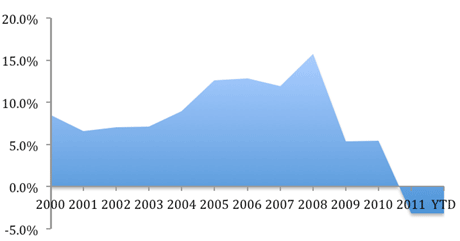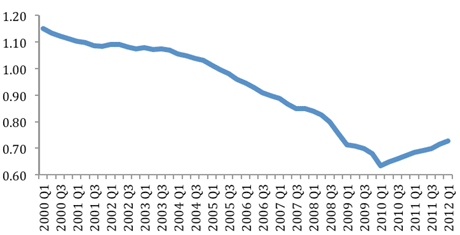The Bank of England may need to print a lot more than £50bn
The Bank of England is to print another £50bn in the hopes of boosting the economy. But it won't be anything like enough. Phil Oakley explains why, and what it means for you.
The economic storm clouds are getting darker. Despite the government running big budget deficits and the Bank of England printing money, Britain's economy is stuck in a rut. With interest rates near zero, the economic policy makers are running out of options.
So it's little wonder that the Bank has decided to print another £50bn today.
Will it work? Given that the £325bn printed so far hasn't done the trick, probably not. In fact, it's just giving an easy profit opportunity to overstretched banks while destroying the incomes of pensioners by keeping bond yields artificially low.
MoneyWeek
Subscribe to MoneyWeek today and get your first six magazine issues absolutely FREE

Sign up to Money Morning
Don't miss the latest investment and personal finances news, market analysis, plus money-saving tips with our free twice-daily newsletter
Don't miss the latest investment and personal finances news, market analysis, plus money-saving tips with our free twice-daily newsletter
Yet the Bank of England will probably stick with this strategy. As my colleague Matthew Partridge noted this morning, inflation is the easiest way outas far as our politicians and policy makers are concerned.
But to get the economy out of its debt problem will need money printing on an unprecedented scale. And there's a strong risk that this could destroy the value of the pound in our pockets.
Households and the governments still have too much debt
The Bank of England is right to be worried about the UK economy. There is little evidence of any sustainable upturn. And why should there be? The government and household sectors still have too much debt. They either cannot or do not want to spend more money they haven't got.
These debts will not be paid off overnight (unless everyone defaults, of course), which means that an economy bumping along is probably the best we can hope for. The problems in the eurozone are not helpful to our exporting sector - but the real problem is the lack of domestic demand.
In the midst of the debate about austerity versus growth, it seems that the growth camp championed by the likes of Paul Krugman, Francois Hollande and Ed Balls are conveniently ignoring one obvious fact: the size of the government is already too big - in the UK it accounts for just under half of all economic activity.
But it has taken on too much debt, so taking on more is not the answer. However, the problem is that, because the state has become so dominant, it means that when you cut government spending, you shrink the main source of income flow in the economy.
What we need is a private sector recovery based on investment that produces sustainable and recurring cash flows ie an economy based on productive investment, rather than consumption (and public sector spending is basically a form of consumption). It also needs to be a big recovery to offset the bloated size of the state.
But even with record low interest rates, firms either don't want to invest or cannot get the money they need from the banks. So that leaves the Bank of England saddled with the job of getting us out of the mess we're in. Interest rates can't go much lower, which leaves us with money printing. But this isn't working either.
To find out why not, we need to go back to some basic economics and the 'Quantity Theory of Money'. This is the theory on which the hopes of the Bank of England and our economy seem to rest on.
Why money printing isn't working
In simple terms, the amount of money in an economy (the money supply, M) multiplied by the number of times it changes hands (the velocity of circulation, V) equals the amount of money GDP in an economy. (Prices, P, multiplied by the number of transactions, T).
MV = PT
What the Bank of England is trying to do is to increase the amount of nominal (money) GDP, in order to lower the debt burden in the economy. It's trying to do this by boosting the supply of money. Of course, the main risk here is that inflation takes off uncontrollably, but if it works, it should erode the real value of all that debt, which is at the root of the economy's problems.
But the strategy is not working. Despite the creation of £325bn of new money, the money supply has been shrinking for the last year. The cash paid to banks for government bonds is not getting into the economy.
UK broad money supply growth

What about the velocity of circulation, how fast is money changing hands? We can work this out using some simple maths by dividing money GDP by the money supply.
UK velocity of circulation

As you can see, during the upswing in the UK economy during the first half of the last decade, money changed hands at a faster rate. It started to fall at the start of 2005 before bottoming at the start of 2010. It has picked up a bit since then, but is nowhere near the levels associated with a healthy economy.
It is clear that the Bank of England's extra money is not getting into the economy. It is not ending up in the hands of people who can or want to spend it. Why? Because we are in a Japanese-style recession where this policy does not work.
You only have to look at the balance sheets of the UK banks to see that they are getting rid of loans and improving their financial positions. Households with too much debt are trying to get their finances in order and are not about to go on a shopping spree.
The level of money GDP growth is slowing down (see chart below) and looks in danger of stalling. It needs to be higher so that tax receipts are big enough to start paying down debt.
Annual change in money GDP

So what can be done? It seems that the Bank of England is going to have to print a lot more money to get the economy moving again. More importantly it is going to have to think about how to get people to spend this money to make it move around the economy faster.
What seems clear is that buying government bonds from banks is not the answer. It could try giving money directly to companies to invest (indeed that's what it has attempted to an extent with the recent deal to lend money to banks expressly for this purpose) or to younger people or pensioners who have a higher propensity to spend. However, a form of this was tried in the US with tax rebates, but most of the money was saved. It didn't work in Japan either.
More worrying is that so much money will have to be printed that it will light the blue touch paper on inflation. Once rooted in the mindset of consumers, they will spend money more quickly to avoid price rises. This may solve the debt problem, but it would destroy the currency as well.
The bond market would probably crack and Pandora's box will have been well and truly opened as my colleague John Stepek pointed out earlier this week.
This is a horrible scenario which Mervyn King is undoubtedly aware of. But he's equally worried that without more money printing, the economy may start to deflate, which given the amount of debt there is around, would be very painful too. Sadly, there is no easy way out for the British economy.
So what do you do about it?
At the moment, deflation may seem to be the biggest immediate threat to the UK and other economies. This partly explains why government bond yields are so low despite high budget deficits. But what about further out?
It seems to us that if politicians are determined to do it, they'll be able to create inflation. They're certainly not keen to take tough decisions needed on government spending and excess welfare liabilities. So they will keep printing money.
This is why you need inflation hedges. You need to protect the purchasing power of your money. Our views on gold as an inflation hedge should be well-known by now. But there are other alternatives such as index-linked bonds and companies with inflation-linked income streams such as UK water companies and electric utilities. You could also look at putting together a portfolio of stocks with higher than average dividend yields that look capable of growing them in the future see here for more on that.
My colleague John Stepek outlines some other ideas for protecting your wealth from a slide in sterling in this week's MoneyWeek magazine cover story. If you're not already a subscriber, subscribe to MoneyWeek magazine.
Get the latest financial news, insights and expert analysis from our award-winning MoneyWeek team, to help you understand what really matters when it comes to your finances.
Phil spent 13 years as an investment analyst for both stockbroking and fund management companies.
After graduating with a MSc in International Banking, Economics & Finance from Liverpool Business School in 1996, Phil went to work for BWD Rensburg, a Liverpool based investment manager. In 2001, he joined ABN AMRO as a transport analyst. After a brief spell as a food retail analyst, he spent five years with ABN's very successful UK Smaller Companies team where he covered engineering, transport and support services stocks.
In 2007, Phil joined Halbis Capital Management as a European equities analyst. He began writing for MoneyWeek in 2010.
-
 Goodwin: A superlative British manufacturer to buy now
Goodwin: A superlative British manufacturer to buy nowVeteran engineering group Goodwin has created a new profit engine. But following its tremendous run, can investors still afford the shares?
-
 Is US stock market exceptionalism over?
Is US stock market exceptionalism over?US stocks trailed the rest of the world in 2025. Is this a sign that a long-overdue shift is underway?